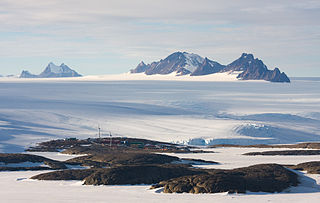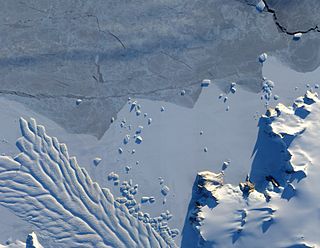The Anare Mountains are a large group of mainly snow-covered peaks and ridges along the northern coast of Victoria Land, Antarctica. The group is bounded on the north and east by the Pacific Ocean, on the west by Lillie Glacier, and on the south by Ebbe Glacier and Dennistoun Glacier. They are north of the Concord Mountains and east of the Bowers Mountains.
Lillie Glacier is a large glacier in Antarctica, about 100 nautical miles long and 10 nautical miles wide. It lies between the Bowers Mountains on the west and the Concord Mountains and Anare Mountains on the east, flowing to Ob' Bay on the coast and forming the Lillie Glacier Tongue.

Lambert Glacier is a major glacier in East Antarctica. At about 80 km (50 mi) wide, over 400 km (250 mi) long, and about 2,500 m (8,200 ft) deep, it is the world's largest glacier. It drains 8% of the Antarctic ice sheet to the east and south of the Prince Charles Mountains and flows northward to the Amery Ice Shelf. It flows in part of Lambert Graben and exits the continent at Prydz Bay.

The Prince Charles Mountains are a major group of mountains in Mac. Robertson Land in Antarctica, including the Athos Range, the Porthos Range, and the Aramis Range. The highest peak is Mount Menzies, with a height of 3,228 m (10,591 ft). Other prominent peaks are Mount Izabelle and Mount Stinear. These mountains, together with other scattered peaks, form an arc about 420 km (260 mi) long, extending from the vicinity of Mount Starlight in the north to Goodspeed Nunataks in the south.
Mawson Peninsula is a high, narrow, ice-covered peninsula on the George V Coast, on the west side of the Slava Ice Shelf, Antarctica, terminating in Cape Hudson. It extends for over 30 nautical miles (56 km) in a northwesterly direction. The peninsula was photographed from the air by U.S. Navy Operation Highjump, 1946–47, and was sketched and photographed by Phillip Law of the Australian National Antarctic Research Expeditions who flew along it to its northern end in February 1959. It was named by the Antarctic Names Committee of Australia for Sir Douglas Mawson.
The Scott Mountains are a large number of isolated peaks lying south of Amundsen Bay in Enderby Land of East Antarctica, Antarctica. Discovered on 13 January 1930 by the British Australian New Zealand Antarctic Research Expedition (BANZARE) under Sir Douglas Mawson. He named the feature Scott Range after Captain Robert Falcon Scott, Royal Navy. The term mountains is considered more appropriate because of the isolation of its individual features.

The David Range (67°54′S62°30′E is a mountain range that extends for 26 kilometres in the Framnes Mountains of Mac.Robertson Land in Antarctica. The range is surrounded by, and largely covered by, an ice sheet. Only the peaks are visible.
Zykov Glacier is a valley glacier about 25 nautical miles long in the Anare Mountains of Victoria Land, Antarctica. It flows northwest and reaches the coast between Cape Williams and Cooper Bluffs. It was photographed by the Soviet Antarctic Expedition (SovAE) in 1958 and named for student navigator Ye. Zykov, who died in Antarctica, Feb. 3, 1957.
Athos Range is the northernmost range in the Prince Charles Mountains of Mac. Robertson Land, Antarctica. The range consists of many individual mountains and nunataks that trend east–west for 40 miles (64 km) along the north side of Scylla Glacier.
Azimuth Islands are a group of 4 small islands lying 1.9 km (1 nmi) northwest of the Parallactic Islands in Holme Bay, Antarctica. They share their name with the largest island in the group, Azimuth Island. Mapped by Norwegian cartographers from air photos taken by the Lars Christensen Expedition, 1936-37. So named by the Antarctic Names Committee of Australia (ANCA) because the largest island in the group was included in a triangulation survey by ANARE in 1959.
The Porthos Range is the second range south in the Prince Charles Mountains of Antarctica, extending for about 30 miles in an east-to-west direction between Scylla Glacier and Charybdis Glacier. First visited in December 1956 by the Australian National Antarctic Research Expeditions (ANARE) southern party under W.G. Bewsher (1956-57) and named after Porthos, a character in Alexandre Dumas, père's novel The Three Musketeers, the most popular book read on the southern journey.
On the continent of Antarctica, the Aramis Range is the third range south in the Prince Charles Mountains, situated 11 miles southeast of the Porthos Range and extending for about 30 miles in a southwest–northeast direction. It was first visited in January 1957 by Australian National Antarctic Research Expeditions (ANARE) southern party led by W.G. Bewsher, who named it for a character in Alexandre Dumas' novel The Three Musketeers, the most popular book read on the southern journey.
Frustration Dome is a large crevassed ice dome about 38 nautical miles (70 km) southeast of Mount Henderson in Mac. Robertson Land, Antarctica. The dome was the site of a tellurometer station established during an Australian National Antarctic Research Expeditions (ANARE) traverse from Mawson Station to Mount Kjerka in 1967, and was so named by ANARE because the traverse party was delayed here by vehicle breakdown, delaying completion of the survey until the next spring.

Matusevich Glacier is a broad glacier about 50 nautical miles long, with a well developed glacier tongue, flowing to the coast of East Antarctica between the Lazarev Mountains and the northwestern extremity of the Wilson Hills.
Fischer Nunatak is a nunatak, 750 metres (2,460 ft) high, standing 2 nautical miles (4 km) south of Mount Henderson in the northeast part of the Framnes Mountains, Mac. Robertson Land, Antarctica.
Hamilton Bluff is a rock bluff on the coast of Antarctica, about 2 nautical miles (4 km) west of Palmer Point and 10 nautical miles (19 km) west of Mount Caroline Mikkelsen. It was first mapped by Norwegian cartographers from air photos taken by the Lars Christensen Expedition, 1936–37. It was visited by I.R. McLeod, geologist with the Australian National Antarctic Research Expeditions (ANARE) Prince Charles Mountains survey party, 1969, and was named by the Antarctic Names Committee of Australia for R. Hamilton, a helicopter pilot with ANARE in 1968.
Mount Henderson is a mountain in the Framnes Mountains of Mac. Robertson Land in the Antarctic. It is southeast of Holme Bay and northeast of the Masson Range.
Topografov Island is an island just north of Partizan Island in the north part of the entrance to Langnes Fjord, Vestfold Hills in Antarctica. Mapped by Norwegian cartographers from air photos taken by the Lars Christensen Expedition (1936–37). Subsequently, photographed by U.S. Navy Operation Highjump (1946–47), ANARE (1954–58) and the Soviet Antarctic Expedition (1956). The latter named it Ostrov Topografov.
Mount Tomlinson is a mountain 2 nautical miles (3.7 km) south of Mount Marsland in the northeast part of the Scott Mountains, Enderby Land of Antarctica. It was plotted from air photos taken from ANARE aircraft in 1956 and was named by the Antarctic Names Committee of Australia (ANCA) for R.C. Tomlinson, a member of the crew of the Discovery during the British Australian New Zealand Antarctic Research Expedition (BANZARE) of 1929–31. Mount Thomlinson has an elevation of 2451m.
Mount Cook is a mountain, roughly 1,900 m high, that is the highest point of the main massif of the Leckie Range in Antarctica. Approximately mapped by Norwegian cartographers on Norwegian whalers chart No. 3. Plotted from air photos taken by ANARE in 1956, and first visited by G.A. Knuckey of ANARE in December 1956, when its position was fixed. Named by Antarctic Names Committee of Australia (ANCA) for B.G. Cook, geophysicist at Mawson station in 1958.
![]() This article incorporates public domain material from "Mount Saw". Geographic Names Information System . United States Geological Survey.
This article incorporates public domain material from "Mount Saw". Geographic Names Information System . United States Geological Survey. 


